[R] Practicing linear regression and decision tree with insurance cost data
Practicing linear regression and decision tree with insurance cost data(from Kaggle)
(1) Downloading the data
Medical Cost Personal Datasets : https://www.kaggle.com/mirichoi0218/insurance
(2) Opening the downloaded csv file
insurance = read.csv('data/insurance.csv')
(3) Using summary( ), to get descriptive statistics
summary(insurance)
## age sex bmi children
## Min. :18.00 Length:1338 Min. :15.96 Min. :0.000
## 1st Qu.:27.00 Class :character 1st Qu.:26.30 1st Qu.:0.000
## Median :39.00 Mode :character Median :30.40 Median :1.000
## Mean :39.21 Mean :30.66 Mean :1.095
## 3rd Qu.:51.00 3rd Qu.:34.69 3rd Qu.:2.000
## Max. :64.00 Max. :53.13 Max. :5.000
## smoker region charges
## Length:1338 Length:1338 Min. : 1122
## Class :character Class :character 1st Qu.: 4740
## Mode :character Mode :character Median : 9382
## Mean :13270
## 3rd Qu.:16640
## Max. :63770
- There are four numerical data: age, BMI, children and charges.
- There are three categorical data: sex, smoker and region.
(4) Making histograms with numerical data and tables with categorical data
hist(insurance$age)
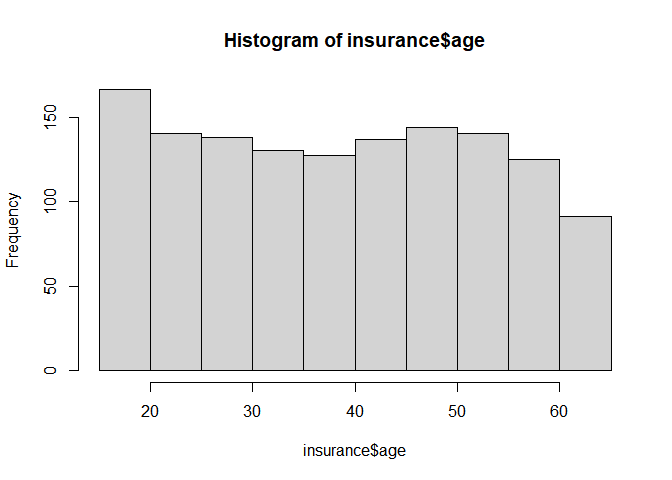
hist(insurance$bmi)
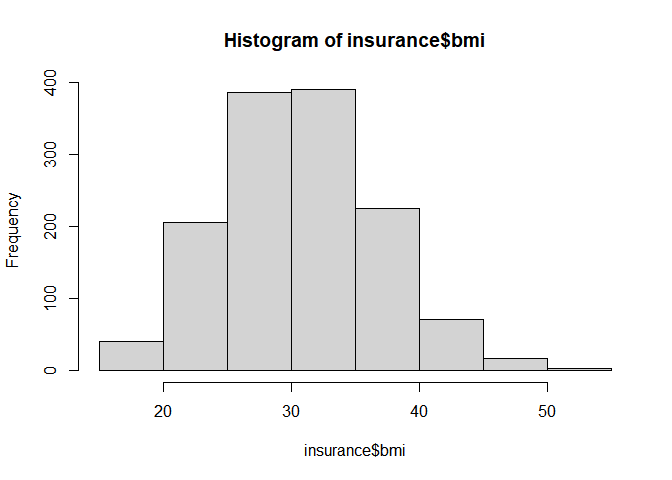
hist(insurance$children)
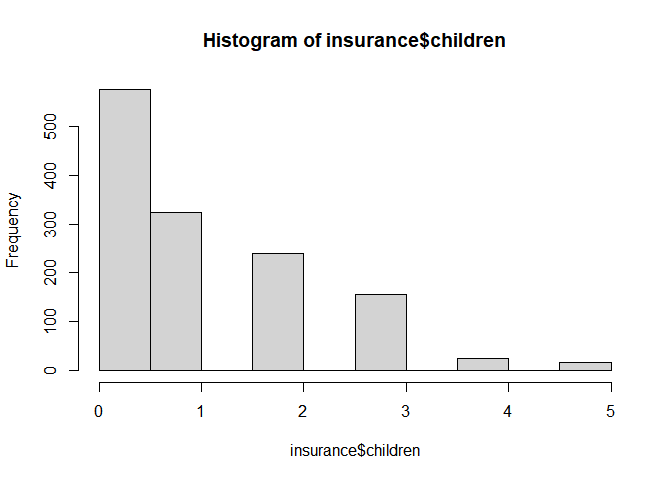
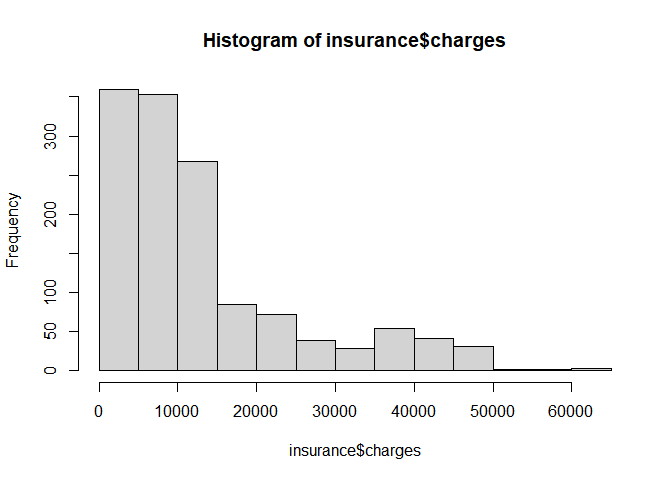
table(insurance$sex)
##
## female male
## 662 676
table(insurance$smoker)
##
## no yes
## 1064 274
table(insurance$region)
##
## northeast northwest southeast southwest
## 324 325 364 325
(5) Numerical data - making a scatterplot and calculating correlation coefficient between BMI and charges
plot(insurance$bmi, insurance$charges, pch=16)

cor(insurance$bmi, insurance$charges)
## [1] 0.198341
- A weak and suspicious positive correlation is found. This alone cannot guarantee us very much about the correlation.
(6) Categorical data - making boxplots of charges by regions, and calculating average charges by regions
boxplot(charges ~ region, data=insurance)

aggregate(charges ~ region, data=insurance, mean)
## region charges
## 1 northeast 13406.38
## 2 northwest 12417.58
## 3 southeast 14735.41
## 4 southwest 12346.94
- The average charges in southeast region is higher than the others.
- In the boxplot, the median values of insurance charges in each region look pretty much similar, yet the top 50 percent of insurance charges in southeast are more expensive than those of the others.
(7) Applying multiple linear regression when the variable of interest variable charges and the others are explanatory variables
lm_ins = lm(charges ~ ., data=insurance)
summary(lm_ins)
##
## Call:
## lm(formula = charges ~ ., data = insurance)
##
## Residuals:
## Min 1Q Median 3Q Max
## -11304.9 -2848.1 -982.1 1393.9 29992.8
##
## Coefficients:
## Estimate Std. Error t value Pr(>|t|)
## (Intercept) -11938.5 987.8 -12.086 < 2e-16 ***
## age 256.9 11.9 21.587 < 2e-16 ***
## sexmale -131.3 332.9 -0.394 0.693348
## bmi 339.2 28.6 11.860 < 2e-16 ***
## children 475.5 137.8 3.451 0.000577 ***
## smokeryes 23848.5 413.1 57.723 < 2e-16 ***
## regionnorthwest -353.0 476.3 -0.741 0.458769
## regionsoutheast -1035.0 478.7 -2.162 0.030782 *
## regionsouthwest -960.0 477.9 -2.009 0.044765 *
## ---
## Signif. codes: 0 '***' 0.001 '**' 0.01 '*' 0.05 '.' 0.1 ' ' 1
##
## Residual standard error: 6062 on 1329 degrees of freedom
## Multiple R-squared: 0.7509, Adjusted R-squared: 0.7494
## F-statistic: 500.8 on 8 and 1329 DF, p-value: < 2.2e-16
- In the result, for example, when every one year increase in age, the model predicts an increase of 256.9 dollars.
- Under the same conditions but when a patient is a male, the model predicts a decrease of 131.3 dollars.
(8) Applying decision tree when the variable of interest variable charges and the others are explanatory variables
library(rpart)
tree_ins = rpart(charges ~ ., data=insurance)
tree_ins
## n= 1338
##
## node), split, n, deviance, yval
## * denotes terminal node
##
## 1) root 1338 196074200000 13270.420
## 2) smoker=no 1064 38188720000 8434.268
## 4) age< 42.5 596 13198540000 5398.850 *
## 5) age>=42.5 468 12505450000 12299.890 *
## 3) smoker=yes 274 36365600000 32050.230
## 6) bmi< 30.01 130 3286655000 21369.220 *
## 7) bmi>=30.01 144 4859010000 41692.810 *
library(rpart.plot)
rpart.plot(tree_ins)
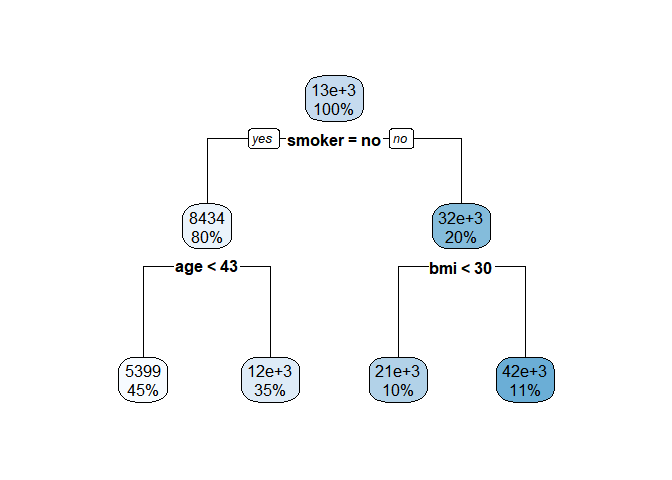
- Depending on a patient’s smoking status, the data is divided into 8: 2 with a large difference in insurance costs. Smokers pay a lot more than non smokers, and whose BMI level is over 30(falling within the obesity range) pay more than the rest of the smokers.
- Meanwhile non-smokers have difference in insurance costs depending on whether they are over 43 years or not.
Reference
- 패스트 캠퍼스 데이터 분석 입문 올인원 패키지 강의
